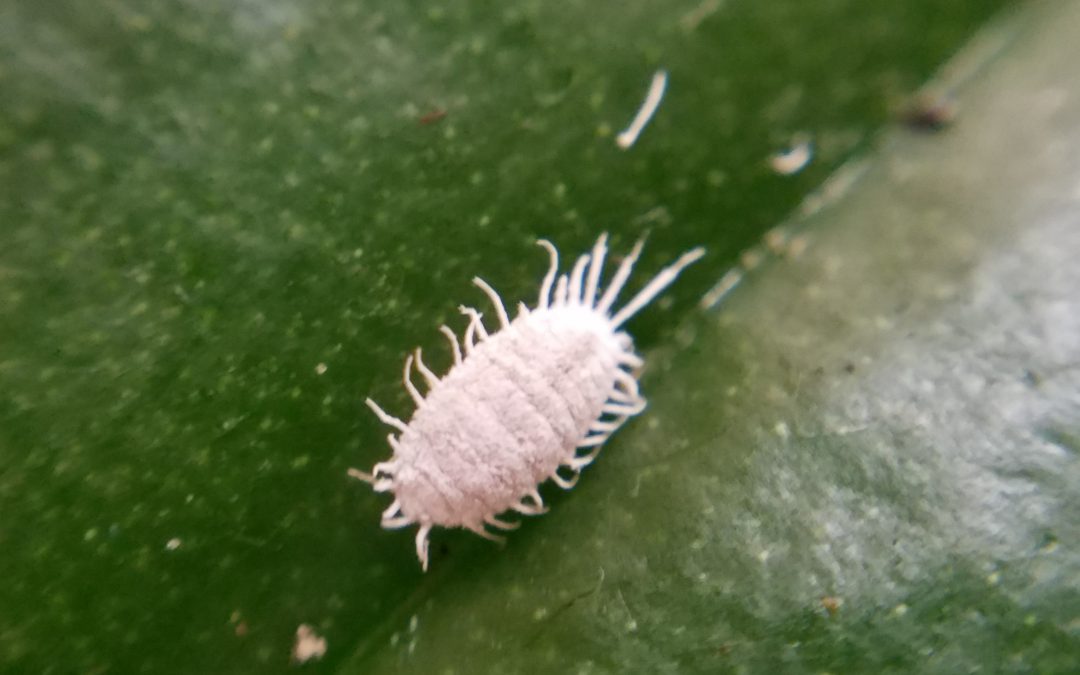
by Evan Anderson | Jun 24, 2021
There are lots of plant pests out there, and it can take a trained eye to tell which one is doing damage. Many of the insect pests that feed on crops and ornamentals have piercing-sucking mouthparts. These insects do not chew on leaves and leave holes behind; instead, they have a long stylus-like mouthpart they use like a straw to suck out plant juices. Over time this can weaken plants, cause irregular growth as damage builds up on new sprouts, introduce diseases to their hosts, and even cause mold to grow on leaves.
Because they drink so much fluid for their meals, many piercing-sucking insects exude a sugary liquid called honeydew. This liquid drops onto stems and leaves below which can leave them shiny and sticky. Eventually, the coating will grow a light greyish coating of sooty mold, which doesn’t do much harm to the plants itself but is a good indicator that you have an insect problem. You may also notice ants on your plants, working to harvest the honeydew for food. The ants don’t harm the plant, but following are some of the pests that do:
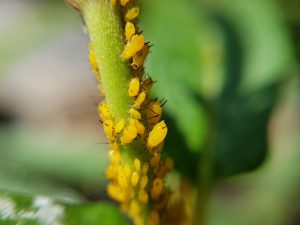
Aphids feeding on a plant stem.
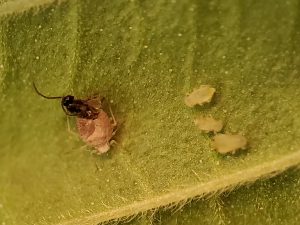
A parasitic wasp emerging from a dead aphid.
Aphids – Found on a wide variety of plants, aphids are fat-bodied little insects that often focus on new, tender growth. Their color depends on the plant they’re feeding on, and they can breed explosively. A female aphid does not need to mate to produce offspring, so a one can produce a lot of children very quickly. Look closely and you might be able to see their cornicles, which look like little tailpipes; these can help identify these pests. Luckily, we have some help in controlling aphids, as they are often parasitized by wasps. If you see large, swollen, brown aphids present, you probably have some wasps working for you.
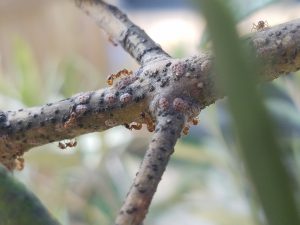
Ants tending some scale insects on a stem.
Scale Insects – Sometimes appearing to just be a bump on a stem or leaf, scale insects don’t move once they pick a plant to live on. Prolific producers of honeydew, some species grow a waxy shell which can protect them and make them difficult to deal with.
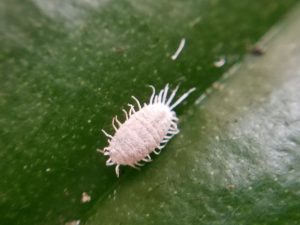
A mealybug.
Mealybugs – If you spy something white and fluffy living on stems or leaves, you might have mealybugs. Soft-bodied insects that are related to scales, they don’t move much. They feed on a wide range of host plants, but can effectively be controlled with a variety of methods once they’re found.
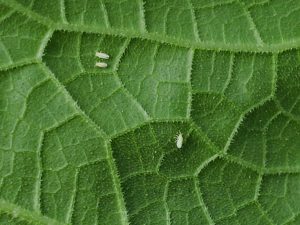
Whiteflies on the underside of a leaf.
Whiteflies – Not true flies, they are truly white in color. Tiny little members of the order Hemiptera (the same order that includes, aphids, scales, and mealybugs), they hang around the undersides of leaves. They enjoy warm weather and can become a problem in greenhouses. They are a bit more difficult to control than some of the other pests listed here.
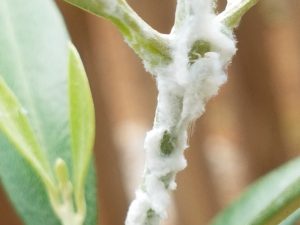
A psyllid nymph hiding in its waxy coating.
Psyllids and planthoppers – Small jumping insects that affect a variety of plant species, some are responsible for transmitting important plant diseases. Pierce’s disease of grapes and citrus greening, for example, are both vectored by these critters. Young nymphs sometimes secrete a waxy coating which may make them look similar to mealybugs.
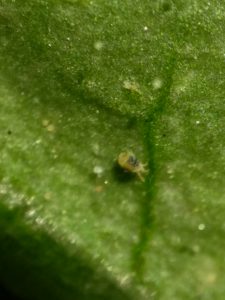
A tiny two-spotted spider mite.
Spider Mites – Not an insect but an arachnid, spider mites love hot, dry weather. Almost microscopic in size, the damage they do to leaves is often the first sign that they are present. Looking closely, one might notice tiny webbing where the mites live, or even the mites themselves on the undersides of leaves and on stems.
Many of these pests can be treated with a combination of methods. A sharp jet of water can dislodge some, hand removal can reduce populations even more, and products such as insecticidal soap or horticultural oils can finish them off. Insecticidal soaps are best used on soft-bodied insects such as aphids or mealybugs, while oils such as neem can help suffocate hard scales. Use products such as horticultural oil in the evening during hot weather to avoid damaging plant tissues with intense sunlight. Thorough coverage is important, as these products only control the pests they contact.
For more information on controlling insects, see our EDIS publications, such as Insect Management in the Home Garden or Landscape Integrated Pest Management.
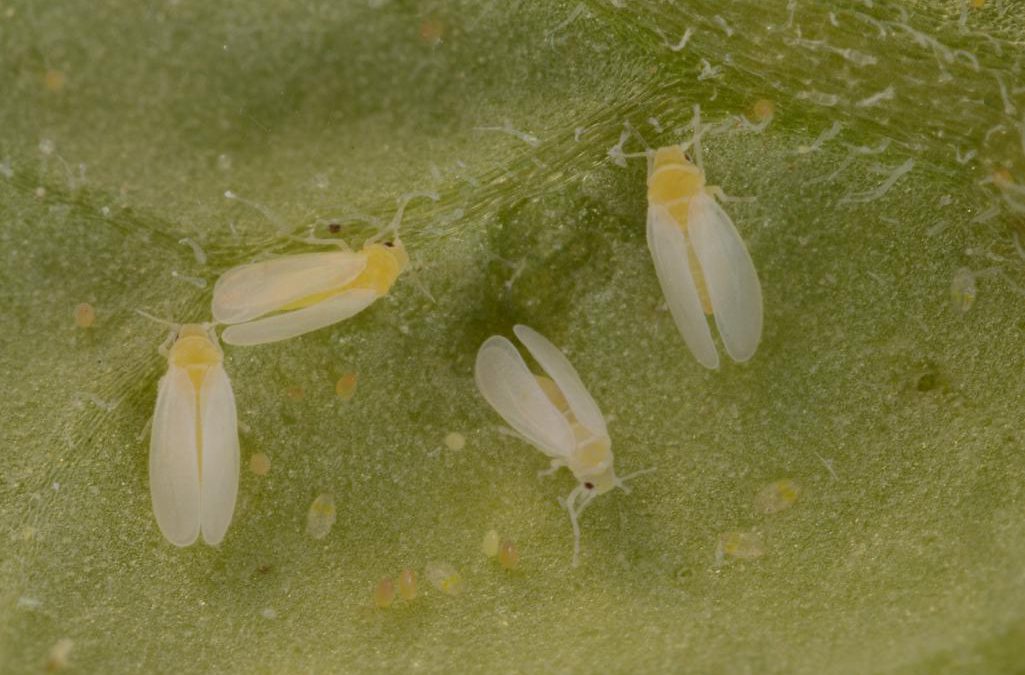
by Danielle S. Williams | Sep 14, 2020
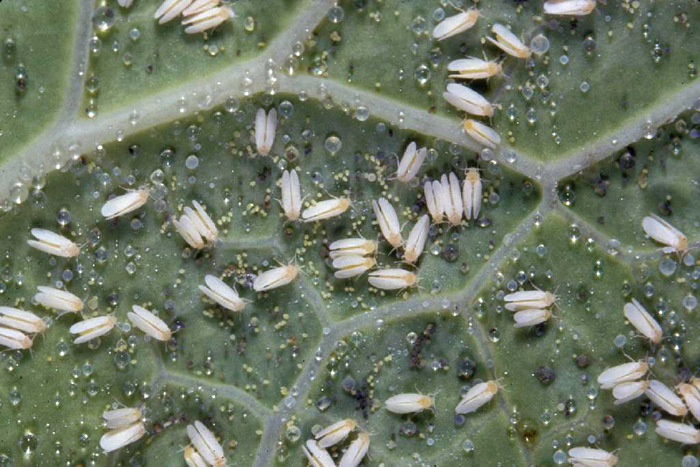
Whitefly adults and eggs. Photo Credit: James Castner, University of Florida, IFAS.
Whiteflies are a pest we typically see in the fall but if you look around, you’ll notice high densities of them now. Despite their name, whiteflies are more closely related to an aphid or scale insect than a fly. They are 1/16 of an inch long (about the size of a gnat) and resemble small moths. They can be found on the undersides of host plant leaves and their behavior is easily recognizable as they scatter from the leaves when they are disturbed.

Silverleaf Whitefly. Photo by Lyle Buss, UF/IFAS
You’ll find whiteflies on a variety of plants ranging from ornamentals such as ficus, poinsettia, hibiscus, and ivy to vegetables like tomato, pepper, eggplant and okra. Some species feed on sweet potatoes, vegetables in the cabbage family, and citrus.
There are several species of whiteflies in Florida but the three main species of agricultural and horticultural concern are the silverleaf whitefly (also known as the sweet potato whitefly), citrus whitefly, and the ficus whitefly. Whiteflies have piercing-sucking mouthparts with which they feed on plants. The top side of leaves on infested plants may become pale or spotted due to whiteflies feeding on the undersides of leaves. It’s not uncommon for an infestation of whiteflies to go unnoticed until leaves turn yellow or drop unexpectedly. Some whitefly species can cause greater damage by transmitting plant viruses.
Whiteflies, along with aphids, scales and mealybugs excrete a sugary substance known as honeydew. This honeydew coats the surface of the plant where the insect feeds and facilitates the growth of a black fungus called sooty mold. Ants and wasps also feed on the honeydew secreted by these insects and may serve as an indicator that a plant is infested with whiteflies or other honeydew secreting insects.
Adult female whiteflies can lay anywhere from 200-400 eggs in her lifetime. The eggs are laid on the undersides of leaves. These eggs hatch into nymphs (also known as crawlers) after 4-12 days. From there, the crawlers will insert their mouthparts into the leaves of host plants where they will molt, pupate and then become adult whiteflies. This process takes anywhere from four weeks to six months, depending on temperature and humidity.
Whiteflies are difficult to control due to their prolific reproductive cycle. It is difficult to get rid of whiteflies once there is an infestation. As with dealing with most insects, proper plant selection, irrigation, and fertilization are critical for managing whiteflies. Removing sources of infestation such as weeds around the garden or old plant debris around the yard can help prevent whitefly populations from carrying over to the next season. Natural predators such as lady beetles, lacewings and predatory mites can help keep whitefly populations in check.
Insecticides such as insecticidal soap or horticultural oil can be used to help reduce whitefly populations. Be sure to always read the label for instructions. For more information on whiteflies, please contact your local UF/IFAS Extension Office.

by Matt Lollar | Oct 2, 2017
Over the last month or so, home gardeners and commercial growers alike have noticed what look to be large dust particles floating through the air. It’s probably not uncommon to have inhaled a few or even a few hundred of these mysterious particles. Most likely, these “particles” aren’t dust at all but whiteflies instead. Whiteflies are small (less than a tenth of an inch long), white, soft-bodied insects. They aren’t flies but are considered ‘true bugs’ by entomologists. The most common whitefly species in Northwest Florida is the silverleaf whitefly, also known as the sweetpotato whitefly. Whitefly numbers have exploded exponentially this year because of last years’ mild winter. These irksome insects feed on a variety of annuals, shrubs, vegetables and trees.

Magnified whitefly adults and eggs. Photo Credit: James Castner, University of Florida/IFAS.
Whiteflies typically feed on the underside of leaves. Initially, disturbed leaves will become pale in color, then a sticky substance may develop on the surface of the leaves. This sticky substance is called honeydew. Honeydew is actually a sugary substance excreted by the whiteflies as part of their elimination process, similar to what aphids and scale insects produce. After honeydew is deposited, sooty mold develops to feed on this readily available sugar source. Sooty mold is a fungus that forms a gray to black colored coating on plant leaves. It normally grows on leaves that were previously covered with honeydew. Sooty mold hinders the ability of leaves to absorb light and ultimately limits photosynthesis.
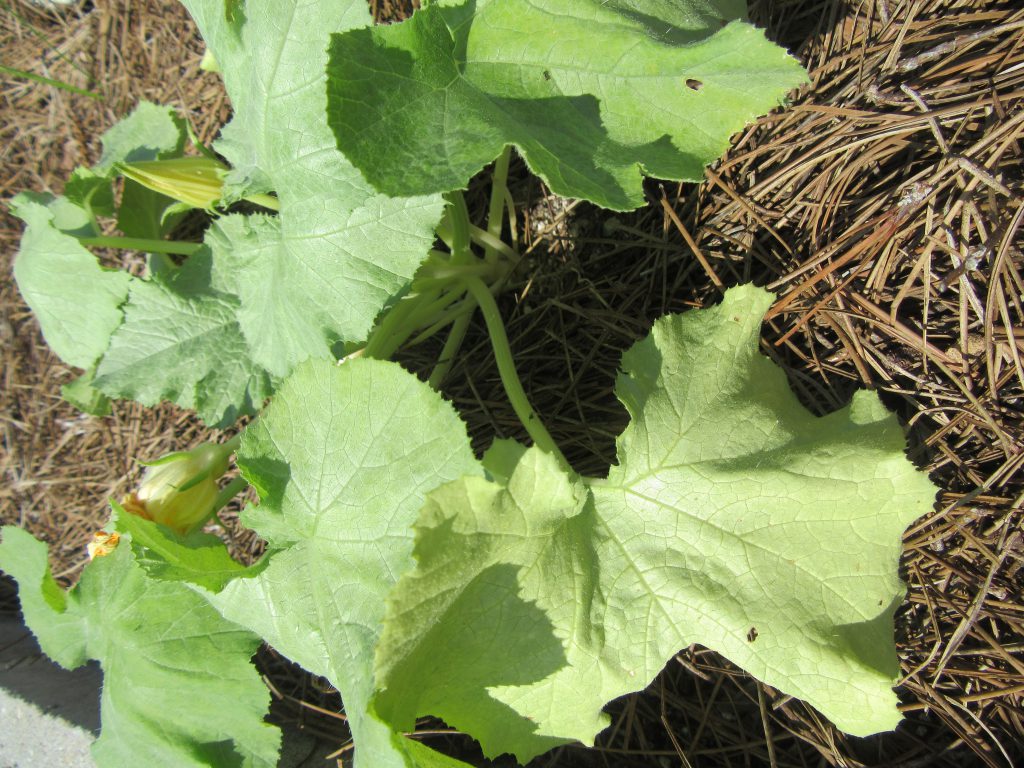
Pale squash leaves due to feeding from whiteflies. Photo Credit: University of Florida/IFAS.
So what should be done to control whiteflies? It depends on what is being grown. If whiteflies are present, the role of beneficial insects should be taken into consideration. Plenty of predatory insects such as lady bugs and green lacewings are around to feed on whiteflies. In fact, leaving the whiteflies alone on your trees and shrubs will attract more predatory insects. Below are some whitefly control methods that produce minimal damage to beneficial insect populations.
Whitefly Control in Vegetables
- Sticky Traps – Yellow sticky traps are a good way to monitor whitefly populations and can help determine when insecticide application is appropriate.
- Insecticidal Soaps – Insecticidal soaps are usually applied as a 1 to 2 percent solution (2½ to 5 tablespoons per gallon of water). It is important to follow the application directions on the label. Insecticidal soap should be applied in the evening, when the sun is low in the sky and the temperature is below 85°F. Some insecticidal soaps available at local lawn and garden centers include: Bonide Insecticidal Soap, Bonide Insecticidal Soap, and Bayer Advanced Natria Insecticidal Soap.
- Horticultural Oils – Horticultural oils should be handled like insecticidal soaps. Like the soaps, they should be applied in the evening. Some horticultural oils available at local lawn and garden centers include: Bonide All Seasons Spray Oil, Southern Ag Parafine Oil, and Garden Safe Neem Oil.
- Other Insecticides – Harsher chemicals are not recommended for the home gardener, because whiteflies have become resistant to most products on the market. Use of broad spectrum insecticides may also contribute to an increase in whitefly populations because they kill beneficial predatory insects.
Hopefully winter will be cooler this year and the profuse whitefly population will be knocked back. Until then, we wish all home gardeners the best of luck with fall gardening!












